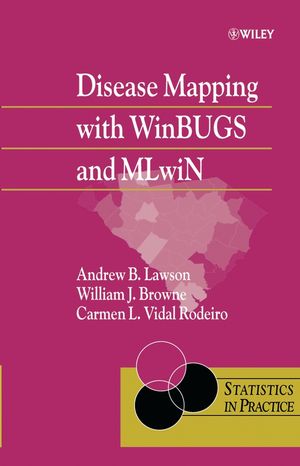Disease Mapping with WinBUGS and MLwiNISBN: 978-0-470-85604-8
Hardcover
296 pages
September 2003
 This is a Print-on-Demand title. It will be printed specifically to fill your order. Please allow an additional 10-15 days delivery time. The book is not returnable.
|
||||||
Notation.
0.1 Standard notation for multilevel modelling.
0.2 Spatial multiple-membership models and the MMMC notation.
0.3 Standard notation for WinBUGS models.
1. Disease mapping basics.
1.1 Disease mapping and map reconstruction.
1.2 Disease map restoration.
2. Bayesian hierarchical modelling.
2.1 Likelihood and posterior distributions.
2.2 Hierarchical models.
2.3 Posterior inference.
2.4 Markov chain Monte Carlo methods.
2.5 Metropolis and Metropolis–Hastings algorithms.
2.6 Residuals and goodness of fit.
3. Multilevel modelling.
3.1 Continuous response models.
3.2 Estimation procedures for multilevel models.
3.3 Poisson response models.
3.4 Incorporating spatial information.
3.5 Discussion.
4. WinBUGS basics.
4.1 About WinBUGS.
4.2 Start using WinBUGS.
4.3 Specification of the model.
4.4 Model fitting.
4.5 Scripts.
4.6 Checking convergence.
4.7 Spatial modelling: GeoBUGS.
4 .8 Conclusions.
5. MLwiN basics.
5.1 About MLwiN.
5.2 Getting started.
5.3 Fitting statistical models.
5.4 MCMC estimation in MLwiN.
5.5 Spatial modelling.
5.6 Conclusions.
6. Relative risk estimation.
6.1 Relative risk estimation using WinBUGS.
6.2 Spatial prediction.
6.3 An analysis of the Ohio dataset using MLwiN.
7. Focused clustering: the analysis of putative health hazards.
7.1 Introduction.
7.2 Study design.
7.3 Problems of inference.
7.4 Modelling the hazard exposure risk.
7.5 Models for count data.
7.6 Bayesian models.
7.7 Focused clustering in WinBUGS.
7.8 Focused clustering in MLwiN.
8. Ecological analysis.
8.1 Introduction.
8.2 Statistical models.
8.3 WinBUGS analyses of ecological datasets.
8.4 MLwiN analyses of ecological datasets.
9. Spatially-correlated survival analysis.
9.1 Survival analysis in WinBUGS.
9.2 Survival analysis in MLwiN.
10. Epilogue.
Appendix 1: WinBUGS code for focused clustering models.
A.1: Falkirk example.
A.2: Ohio example.
Appendix 2: S-Plus function for conversion to GeoBUGS format.
Bibliography.
Index.



